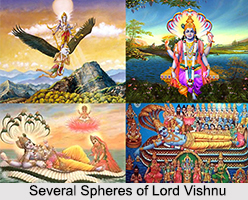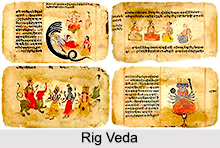 Lord Vishnu in Rig Veda is accorded a high place. He is held as the one Supreme deity and the ultimate reality. Vishnu in the Rig Veda is one among the other deities and He was raised to the status of a Supreme Being at a later period by the Epics and Indian Puranas. Vishnu is the Supreme Deity and is to be determined with reference to the essential characteristics which define the ultimate Reality. Vedanta Desika has offered several definitions of the Supreme Lord. These serve as the criteria to determine the Supremacy of a deity. A deity who claims the status of the Supreme Being should be all-pervasive (sarva-vyapi), imminent in all beings as inner controller (antaratma), should be the ground (adhara) of all that exists in the universe and that it should be the sovereign of the entire universe (sarve-svara). The hymns of the Rig Veda are addressed to the different deities including Vishnu, taking into consideration the interpretations offered by ancient Vedic commentators and exponents of the Vedanta.
Lord Vishnu in Rig Veda is accorded a high place. He is held as the one Supreme deity and the ultimate reality. Vishnu in the Rig Veda is one among the other deities and He was raised to the status of a Supreme Being at a later period by the Epics and Indian Puranas. Vishnu is the Supreme Deity and is to be determined with reference to the essential characteristics which define the ultimate Reality. Vedanta Desika has offered several definitions of the Supreme Lord. These serve as the criteria to determine the Supremacy of a deity. A deity who claims the status of the Supreme Being should be all-pervasive (sarva-vyapi), imminent in all beings as inner controller (antaratma), should be the ground (adhara) of all that exists in the universe and that it should be the sovereign of the entire universe (sarve-svara). The hymns of the Rig Veda are addressed to the different deities including Vishnu, taking into consideration the interpretations offered by ancient Vedic commentators and exponents of the Vedanta.
Hymns on Lord Vishnu
Lord Vishnu in the Rig Veda qualifies fully to be considered as the Supreme Being (Isvara). This can be made clear by examining the meaning and implications of a few selected hymns addressed to Vishnu.
In the first place, the all-pervasive character (sarvavyapakatva) of Vishnu has been explicitly brought out in more than one hymn of the Rig Veda. There are eight hymns appearing in the very first mandala of the Rig Veda Samhita that speak about the greatness of Vishnu by repeatedly referring to the three strides with which He measured the entire universe. The description of Vishnu with three strides signifies symbolically that the entire universe is pervaded by Vishnu. This implies that Vishnu along with the creation of the entire universe pervades all that is created. The created entities derive their existence (satta) by the immanence of the creator as its inner self.
The Upanishad expresses this truth in a different way. According to the Vedic etymology of Yaska, the term Vishnu means the one who pervades everything. It is also interpreted as the one who enters into all. The "Ahirbudhnya Samhita", an authoritative Pancharatra treatise, upholds both the meanings.
 The most important hymn which establishes beyond any doubt the supremacy of Vishnu is the one which speaks of the eternal abode or Paramapada of Vishnu. The hymn runs as follows: "The enlightened seers (suris) always see that supreme abode of Vishnu, like the shining sun pervading the entire sky as if it were an eye fixed in the heaven". The word Vishnu in this hymn refers to Para-Brahma because the supreme abode as existent eternally should belong to the eternal Supreme Being. The suris (seers) are those individual souls who are eternally free. They are endowed with perfect knowledge implying that they are omniscient. Only such individuals can have the vision of Vishnu and His eternal abode. The word Paramapada also means the Swarupa or nature of Vishnu in the sense that he is to be attained. It is only through the spiritual knowledge acquired after release from bondage that it is possible to have the vision of Vishnu"s abode.
The most important hymn which establishes beyond any doubt the supremacy of Vishnu is the one which speaks of the eternal abode or Paramapada of Vishnu. The hymn runs as follows: "The enlightened seers (suris) always see that supreme abode of Vishnu, like the shining sun pervading the entire sky as if it were an eye fixed in the heaven". The word Vishnu in this hymn refers to Para-Brahma because the supreme abode as existent eternally should belong to the eternal Supreme Being. The suris (seers) are those individual souls who are eternally free. They are endowed with perfect knowledge implying that they are omniscient. Only such individuals can have the vision of Vishnu and His eternal abode. The word Paramapada also means the Swarupa or nature of Vishnu in the sense that he is to be attained. It is only through the spiritual knowledge acquired after release from bondage that it is possible to have the vision of Vishnu"s abode.
Significance of the Three Strides of Lord Vishnu
The philosophical significance of the three strides of Vishnu has been brought out more explicitly in the "Shatapatha Brahmana". The passage says: Vishnu is the very sacrifice (yajna). He measured the entire universe for the sake of divine beings (devatas); the strides are; the pervasion of the entire physical earth by the first step, the entire upper region by the second and the heavenly region by the third step.
Some ancient commentators on the Vedas and also a few Western scholars have taken the view that Vishnu is Sun God (Surya) and the three steps represent the rising sun in the early morning, the sun in the noon and the setting sun in the evening. The three steps are also interpreted as the manifestation of sun in three different forms, first as agni (fire) in the earthly region, the second one as vidyut (lightning) in the upper region (antariksa) and the third in the higher celestial region (divi) as surya (sun).
The number three, as Madhava has interpreted, covers not merely the three worlds, Prithvi, Antariksa and Dyuloka, but the three Vedas (Rig Veda, Yajur Veda and Sama Veda), the three time factors-past, present and future, the three kinds of Jivas; devas, danavas and human beings, the three types of existents-sentient beings (chtana), non-sentient matter (achetana) and the mixed ones (mishra).
The implication of it is that everything that exists in the spatio-temporal universe is pervaded by Vishnu. If this meaning is accepted it becomes obvious that Vishnu of the Rig Veda is the Supreme Being by virtue of His all-pervasive character.









